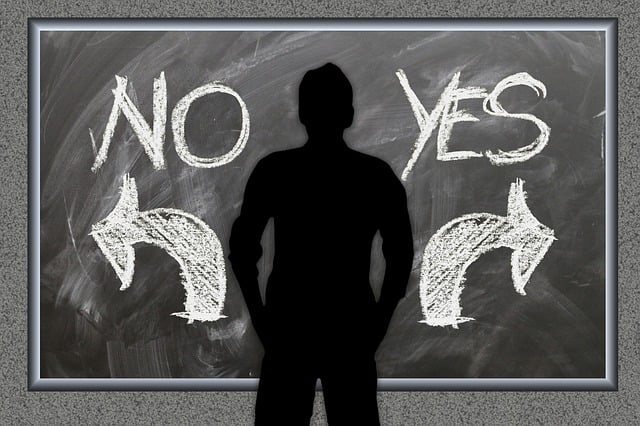Ambivalence is when you have mixed feelings about something and can’t decide if it’s good or bad. Uncertainty is when you don’t know what’s going to happen next. Ambivalence is often seen as a negative thing, because it means you’re stuck in limbo and can’t make a decision. Uncertainty, too is usually seen as a negative thing. This is because uncertainty creates anxiety and stress. When you don’t know what’s going to happen, it’s hard to relax and enjoy life. You may find yourself constantly worrying about the future.
What is ambivalence?
(Image by Gerd Altmann from Pixabay )

There are many ways to think about ambivalence, but at its core, ambivalence is a state of having mixed feelings or contradictory ideas about something. We can be simultaneously drawn to and repelled by the same person, for example, or feel both hopeful and despairing about the future.
Ambivalence can also be seen as a strength: we are complex creatures with the capacity to hold multiple truths in our hearts at the same time. On the other hand, it can be experienced as a form of suffering, as when we can’t make up our minds about what we really want or which path to take.
What is uncertainty?
(Image by Gerd Altmann from Pixabay )

Uncertainty refers to a situation in which the future or outcome of an event is unknown, unpredictable, or ambiguous. It is the lack of information, knowledge, or confidence that can make it difficult to make decisions or take actions. Uncertainty can arise from a variety of factors, including incomplete data, conflicting information, or unexpected changes in circumstances. Uncertainty can lead to anxiety, hesitation, and indecision as individuals and organizations try to navigate complex or unpredictable situations.
Ambivalence VS. Uncertainty – Key differences
Ambivalence and uncertainty are two related but distinct concepts. Here are some key differences:
Definition: Ambivalence refers to having mixed feelings or contradictory attitudes towards something or someone. Uncertainty, on the other hand, refers to a lack of knowledge, information, or confidence about a situation or outcome.
Emotion vs. Cognition: Ambivalence is primarily an emotional state that arises from conflicting feelings or attitudes. Uncertainty, on the other hand, is primarily a cognitive state that arises from a lack of information or knowledge.
Cause: Ambivalence can be caused by conflicting values, beliefs, or experiences. Uncertainty, on the other hand, can be caused by a lack of information, complexity, or unpredictability of a situation.
Outcome: Ambivalence can lead to indecision, procrastination, or avoidance of making a choice. Uncertainty can lead to anxiety, hesitation, and a need for more information or analysis.
Context: Ambivalence is often related to personal relationships, attitudes, or preferences. Uncertainty is often related to complex decision-making in business, science, or other domains.
Ambivalence and uncertainty are two different states of mind with distinct causes, outcomes, and contexts. While ambivalence is primarily an emotional state arising from conflicting feelings, uncertainty is a cognitive state arising from a lack of information or knowledge.
How to deal with ambivalence ?
It can be difficult to deal with ambivalence, because it can feel like you’re stuck in limbo. You may be torn between two different courses of action, or have conflicting feelings about a situation. The key is to try to explore your options and make a decision.
There are a few ways you can deal with ambivalence:
- Talk to someone who can help you sort out your thoughts and feelings. This could be a friend, family member, therapist, or other professional. Talking openly and honestly about what you’re experiencing can help you gain clarity and reach a decision.
- Write down your thoughts and feelings. Sometimes putting your ambivalence into words can help you see the situation more clearly and make a decision.Try brainstorming pros and cons, or writing a letter to yourself from each perspective (e.g., “If I choose option A, this is what will happen…”).
- Consider the consequences of each option. What will happen if you do one thing or the other? Will one choice lead to more happiness or satisfaction than the other? Try to weigh the pros and cons as objectively as possible to help you make a decision.
- Give yourself time – don’t rush into anything. If you’re feeling unsure or ambivalent, it’s okay to take some time to think things through before making a final decision. Once you’ve had time to process your thoughts and feelings, you may find that
How to deal with uncertainty?
When you’re feeling uncertain about something, it’s important to take a step back and assess the situation. What is it that you’re uncertain about? Is it a decision you have to make? A change that’s happening in your life? Once you’ve identified the source of your uncertainty, you can start to work on finding a way to deal with it.
If the uncertainty is coming from a decision you have to make, try to break it down into smaller steps. What are all of the options available to you? What are the pros and cons of each option? Once you’ve looked at the situation from all angles, you may find that the best course of action becomes clear. If not, don’t be afraid to ask for help from someone who can provide more clarity.
If the uncertainty is due to a change that’s happening in your life, such as a new job or moving to a new place, it’s normal to feel some anxiety. Again, it can be helpful to take a step back and assess the situation. What are the potential risks and rewards of this change? How will it impact your day-to-day life? Will there be any challenges that you need to prepare for? Once you have a better understanding of what’s going on, it will be easier to deal with any feelings of uncertainty.
Remember, uncertainty is part of life. It’s okay to feel unsure about things from time to time. Just try not to let it
The benefits of being ambivalent
When it comes to making decisions, there are benefits to being ambivalent. For one, you can avoid feeling like you’re stuck with a single choice. And, if you’re ambivalent about a decision, it means you haven’t fully committed to one option or the other – so you can always change your mind later on.
Being ambivalent also allows you to see both sides of an issue more clearly. When you’re not attached to a particular outcome, you can be more objective in your assessment of the pros and cons. This can help you make a more informed decision when the time comes.
Lastly, if you’re feeling unsure about a decision, it’s OK to take some time to think things through before committing. By beingambivalent, you give yourself the space and freedom to explore all your options before making a final choice.
The drawbacks of being uncertain
- Anxiety: Uncertainty can lead to anxiety and stress as individuals worry about potential outcomes or consequences.
- Indecision: Uncertainty can make it difficult to make decisions, as individuals may lack the information or confidence needed to choose a course of action.
- Procrastination: Uncertainty can also lead to procrastination, as individuals delay making decisions or taking action until they have more information or feel more confident.
- Missed Opportunities: Uncertainty can cause individuals to miss out on opportunities, as they may be hesitant to take risks or pursue new ventures.
- Inefficiency: Uncertainty can lead to inefficiency, as individuals may spend excessive time and resources gathering information or analyzing data.
- Negative impact on mental health: Chronic uncertainty can have a negative impact on mental health, causing depression, anxiety, and other related issues.
Uncertainty can have a variety of negative consequences, both personal and professional. It is important to try to reduce uncertainty where possible, through gathering more information, seeking advice from experts, or taking small steps to test out different options.
What is ambiguity?
When we say that something is ambiguous, we mean that it can be interpreted in more than one way. Ambiguity is often used to refer to language, but it can apply to anything from art to contracts.
One type of ambiguity is called lexical ambiguity, which occurs when a word has more than one meaning. For example, the word “bank” can refer to a financial institution or the edge of a river. Another type of ambiguity is called structural ambiguity, which occurs when the grammar of a sentence allows for more than one interpretation. For example, the sentence “I saw the man with binoculars” could mean that either I was using binoculars to see the man or someone else was using binoculars and I saw that person.
Ambiguity can be frustrating when we’re trying to communicate clearly, but it can also be used deliberately to create confusion or add levity to a situation. In some cases, ambiguity is an unavoidable side effect of language itself.
Featured Image By – Gerd Altmann from Pixabay








